The Ultimate Hiking Guide to Huashan Scenic Area: Routes, Tips, and More
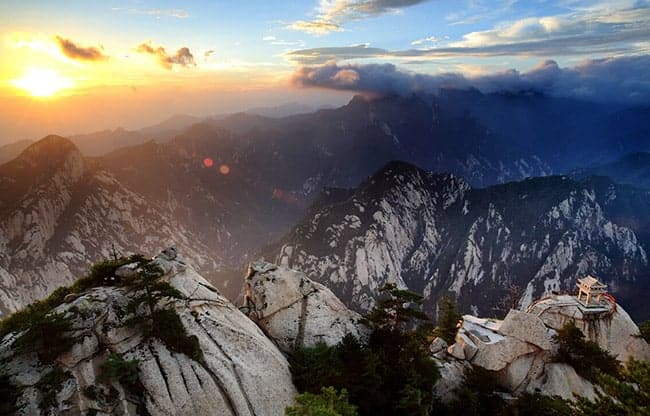
An Essential Guide to Visiting Huashan Scenic Area
In This Guide
- An Essential Guide to Visiting Huashan Scenic Area
- The Rich History and Legends of Huashan Scenic Area
- Main Highlights: What You Absolutely Can’t Miss
- Planning Your Visit: A Practical Guide
- Tickets: Prices, Booking, and Tips
- How to Get There: A Complete Transportation Guide
- Local Cuisine and Accommodation Nearby
- Frequently Asked Questions
- Final Thoughts on Your Trip
Nestled in the heart of Shaanxi Province, just a stone’s throw from the historic city of Xi’an, lies the breathtaking Huashan Scenic Area—one of China’s Five Great Mountains. Revered not just for its stunning natural beauty, but also for its rich tapestry of cultural and historical significance, Huashan stands as a testament to the harmonious blend of human endeavor and natural splendor.
As you approach this majestic mountain range, you’ll be greeted by sheer cliffs that plunge into deep ravines, offering a dramatic landscape that has inspired poets, artists, and adventurers for centuries. Huashan is often dubbed “the most precipitous mountain under heaven,” a phrase that reflects both its daunting heights and its revered status in Chinese folklore and Taoist philosophy. Here, you’ll discover not only the thrill of conquering its rugged terrains but also the serenity of ancient temples and sacred sites that dot the landscape.
Why Visit Huashan?
Visiting Huashan is more than just a hike; it’s a journey into the heart of Chinese history and spirituality. Each of its five peaks—North, South, East, West, and Middle—offers a unique perspective and a different experience, whether you are seeking the best sunset views, the thrill of narrow cliffs, or a peaceful morning sunrise. The mountain is also a pilgrimage site, with Taoist temples and engraved scriptures that echo the philosophies of those who sought enlightenment amidst its heights.
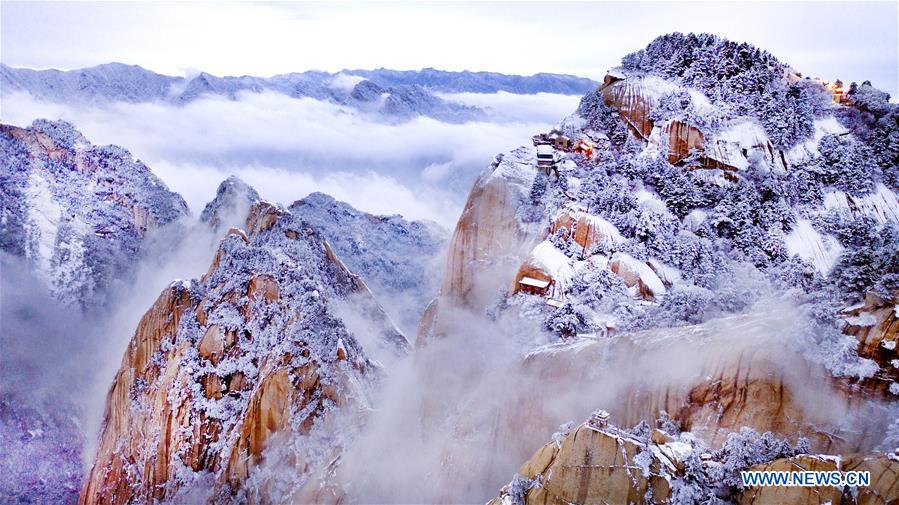
Huashan_Scenic_Area.
Whether you’re a seasoned hiker looking for an adrenaline rush or a curious traveler eager to immerse yourself in culture, Huashan promises an unforgettable adventure. From the exhilarating trails of the Plank Walk to the tranquil beauty of the surrounding landscapes, every step on this sacred mountain reveals a new layer of history and nature waiting to be explored.
Prepare to be captivated by Huashan’s charms as you embark on a journey that combines the thrill of exploration with the wisdom of ancient traditions.

Huashan_Scenic_Area.
The Rich History and Legends of Huashan Scenic Area
Huashan, or Mount Hua, holds a venerable place in Chinese history and culture, revered not only for its breathtaking landscapes but also for its rich tapestry of legends that have captivated the imagination of travelers and scholars alike for centuries. As one of the Five Great Mountains of China, Huashan is steeped in myth, spirituality, and historical significance, making it an essential destination for those seeking to delve into the heart of Chinese heritage.
A Sacred Mountain
Mount Hua has long been associated with Taoism, and it is home to several ancient temples, shrines, and pavilions that are dedicated to its spiritual significance. These structures serve as a testament to the mountain’s role as a center for religious practices and philosophical thought. Among the most notable is the Yuhua Palace (玉华宫), a Taoist temple that has attracted pilgrims for centuries. Here, visitors can find intricate carvings, inscriptions, and relics that reflect the deep-rooted devotion to the mountain’s divine qualities.

Huashan_Scenic_Area.
Legends of Heroism and Romance
The legends surrounding Huashan are as dramatic as its towering cliffs. One of the most famous tales is that of Xu Xian and Bai Suzhen, a love story that has transcended time and inspired countless adaptations in literature and opera. According to the legend, Bai Suzhen, a snake spirit, transforms into a beautiful woman and falls in love with Xu Xian. Their love story leads to many trials, including confrontations with powerful forces that seek to separate them. Legend has it that their adventures took them to Huashan, where the mountain’s mystique provided both refuge and challenge.
Another captivating legend is that of the Sword Competition on Huashan (华山论剑), where legendary swordsmen would gather to test their skills and claim supremacy. This event is more than just a tale of martial prowess; it symbolizes the pursuit of knowledge, mastery, and honor. The competition is said to have taken place on the precipices of Huashan, imbuing the mountain with an aura of bravery and skill that continues to resonate with hikers and adventurers today.
Historical Significance
Throughout history, Huashan has served as a strategic military site, a refuge for monks, and a source of inspiration for poets and artists. Its steep cliffs and narrow paths have been traversed by scholars, monks, and warriors, each leaving behind their imprint on the mountain’s history. During the Tang Dynasty (618–907 AD), Huashan became a sanctuary for poets, and it was here that the famous poet Li Bai is said to have composed verses that celebrated the beauty of the mountain and the philosophy of life.
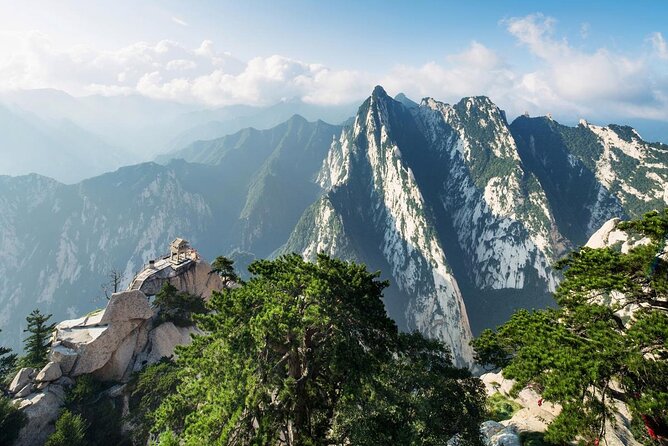
Huashan_Scenic_Area.
Moreover, during the tumultuous periods of Chinese history, such as the Ming (1368–1644) and Qing Dynasties (1644–1912), Huashan served as a refuge for those seeking solace from political unrest. Monks and scholars would gather in its serene surroundings, finding both inspiration and peace amid the chaos of the outside world.
A Mountain of Challenges
Today, Huashan is known not only for its spiritual significance but also for its daunting hiking trails that attract thrill-seekers from around the globe. The most famous of these is the Plank Walk, a narrow walkway that clings to the cliffs, offering breathtaking views and a heart-pounding experience. As hikers navigate these treacherous paths, they can almost hear the echoes of the legends that have been woven into the very fabric of this majestic mountain.
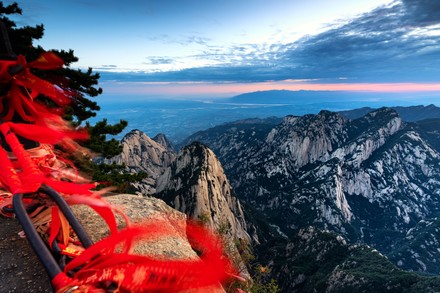
Huashan_Scenic_Area.
Conclusion
Visiting Huashan is not merely an adventure into nature; it is a journey through time, where every rock and path tells a story. From its sacred temples to the legends of love and heroism, Huashan invites travelers to explore not only its stunning vistas but also the rich history and cultural heritage that make it a remarkable destination. Whether you are seeking spiritual enlightenment, a thrill of adventure, or a glimpse into the past, Huashan offers an experience that is as profound as it is exhilarating.
Main Highlights: What You Absolutely Can’t Miss
Unveiling the Wonders of Huashan Scenic Area
Nestled near the ancient city of Xi’an, Mount Huashan (华山) stands as one of China’s Five Great Mountains, a breathtaking marvel that combines natural beauty with rich cultural history. This iconic destination is not only a haven for adventure seekers but also a spiritual retreat steeped in Taoist traditions. Here’s a comprehensive guide to the must-see highlights that you simply cannot miss on your visit to this majestic mountain.
The Majestic Five Peaks
Mount Huashan is renowned for its five distinct peaks, each offering unique perspectives and experiences:
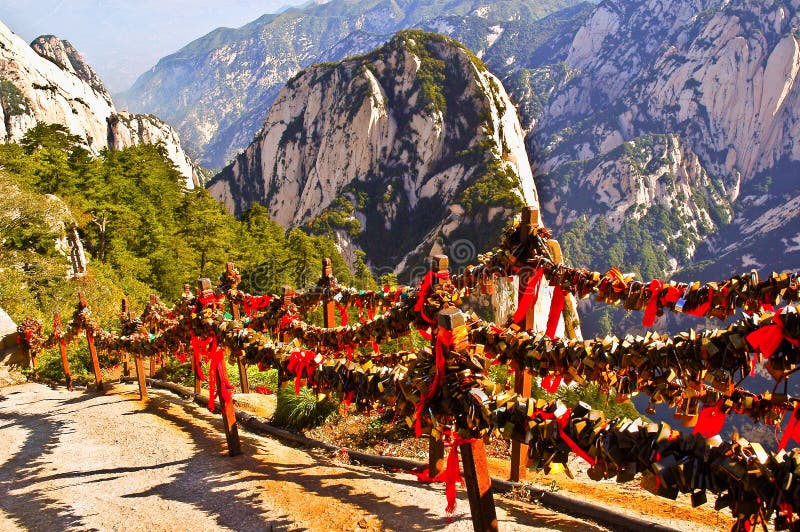
Huashan_Scenic_Area.
- North Peak (北峰)
- Overview: The lowest of the five, North Peak serves as the primary access point for hikers and offers stunning views of the surrounding peaks.
-
Highlights: Explore ancient temples and enjoy the panoramic vistas of East, South, and West Peaks, resembling a large golden ingot.
-
Middle Peak (中峰)
- Overview: A crucial connection between the other peaks, Middle Peak is famous for its thrilling Black Dragon Ridge.
-
Highlights: Experience the narrow path that is less than a meter wide at its thinnest point, with handrails for safety. It’s an exhilarating hike with breathtaking cliffside views.
-
West Peak (西峰)
- Overview: Known for its ethereal beauty, West Peak is the best spot for witnessing unforgettable sunsets.
-
Highlights: Accessible by cableway, it offers spectacular views and is the perfect location to relax and soak in the serene ambiance as the sun sets.
-
East Peak (东峰)
- Overview: Renowned as the ultimate sunrise viewing spot, East Peak draws early risers eager to catch the dawn’s first light.
-
Highlights: Tackle the exhilarating Sparrow Hawk Flips Over, a challenging climb that promises a rush of adrenaline, but be sure to book in advance due to limited slots.
-
South Peak (南峰)
- Overview: The highest peak in the area, South Peak rewards climbers with breathtaking panoramic views.
- Highlights: The famous Plank Walk offers a thrilling experience as you traverse narrow paths above steep drops, providing perfect photo opportunities.
The Thrill of Hiking and Cable Cars
Whether you are an avid hiker or simply wish to enjoy leisurely walks, Mount Huashan caters to all levels of adventure.
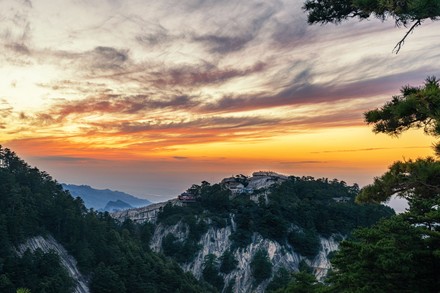
Huashan_Scenic_Area.
- Cable Car Accessibility: Convenient cable cars operate from North Peak and West Peak, allowing visitors to conserve energy for the more challenging trails.
- Recommended Routes:
- Classic Route: Start at North Peak, hike through Middle Peak, and explore East, South, and finally West Peak, making your way down via cable car.
- Sunset Route: Begin at West Peak, enjoy breathtaking views, and descend via the North Peak cableway.
Best Times to Experience Huashan
To make the most of your visit, consider the following seasonal highlights:
- Spring (April to May): Enjoy vibrant peach blossoms and clear skies, perfect for climbing.
- Summer (June to August): Experience lush greenery and stunning sea of clouds, but be prepared for occasional rain.
- Autumn (September to October): Capture the stunning fall colors with comfortable temperatures and fewer crowds.
- Winter (November to March): Witness the enchanting rime and snow, though ensure safety as paths may be icy.
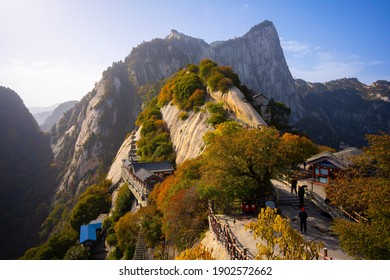
Huashan_Scenic_Area.
Practical Tips for Visitors
- Accommodations: For those wishing to stay overnight, the Mount Hua East Peak Hotel offers basic rooms, while camping at Middle Peak is also an option for the more adventurous.
- Transportation: The easiest way to reach Mount Huashan is by private car from Xi’an, but public transport options like bullet trains are available, with additional transfers needed.
- Safety Precautions: Due to the rugged terrain, ensure you wear appropriate footwear and stay hydrated. Follow safety guidelines, especially on narrow paths.
Conclusion
A journey to Mount Huashan is not merely a hike; it’s an immersion into the heart of China’s breathtaking landscapes and profound cultural heritage. With its awe-inspiring peaks, ancient temples, and thrilling adventures, Huashan promises an unforgettable experience that resonates with both the thrill-seeker and the contemplative traveler alike. Whether you’re looking to conquer its heights or simply bask in its beauty, Mount Huashan should undoubtedly be on your travel itinerary.

Huashan_Scenic_Area.
Planning Your Visit: A Practical Guide
Your Comprehensive Practical Guide to Visiting Huashan Scenic Area
Mount Huashan (华山), a jewel in the crown of China’s Five Great Mountains, offers breathtaking vistas, historical significance, and exhilarating hiking challenges. Nestled near the ancient city of Xi’an, this majestic mountain is not only a paradise for adventurers but also a treasure trove of cultural heritage. Whether you’re a seasoned hiker or a curious traveler, here’s everything you need to know to navigate this iconic destination.
The Majestic Peaks of Huashan
Mount Huashan consists of five distinct peaks, each offering unique experiences:
- North Peak: The lowest yet an essential starting point for hikers. Accessible via cable car, it provides expansive views of the other peaks.
- Middle Peak: A vital connection between the other peaks, featuring the exhilarating Black Dragon Ridge, a narrow path with safety handrails.
- West Peak: Renowned for its stunning sunsets, it is also reachable by cable car, making it a favorite for leisurely visitors.
- East Peak: The best location for witnessing sunrises and known for the thrilling Sparrow Hawk Flips Over climbing challenge.
- South Peak: The highest peak, offering panoramic views and the adventurous Plank Walk, which is a must-try for thrill-seekers.
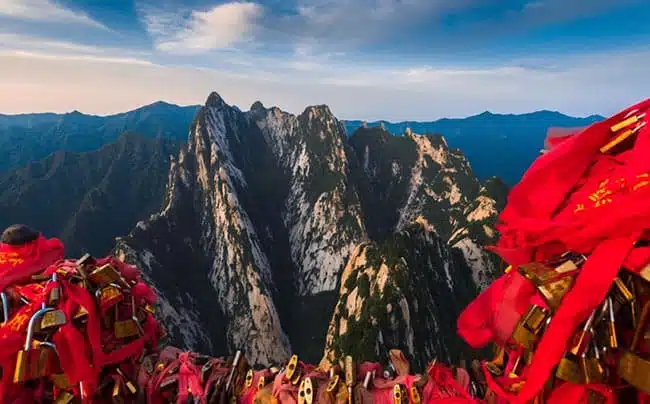
Huashan_Scenic_Area.
Getting There and Around
Transportation Options:
– From Xi’an: The most convenient way to reach Huashan is by private car from your hotel, which takes about 1.5 hours to the tourist center.
– By Train: For a budget-friendly alternative, take a bullet train to Huashan or Huashan North Railway Station, followed by a bus or taxi to the tourist center. Be prepared for possible long waits for transportation.
Cable Cars: Two cableways are available:
– North Peak Cableway: Ideal for those starting their hike here.
– West Peak Cableway: A great option for visitors looking to start their journey from a higher elevation.
Planning Your Hiking Experience
Hiking Routes:
– Classic Route: Start from North Peak, hike to Middle Peak, East Peak, South Peak, and finish at West Peak, then take the cable car down. This route typically takes 5-6 hours.
– Alternative Route: Begin at West Peak, then traverse South Peak, East Peak, Middle Peak, and finish at North Peak. This option is less strenuous, with a predominance of downhill trails.
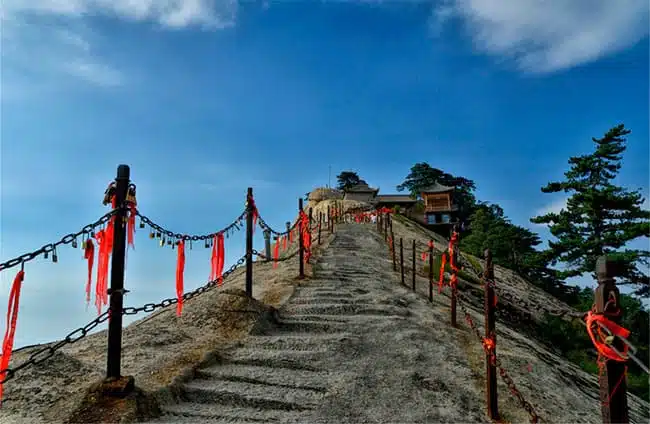
Huashan_Scenic_Area.
Accommodation: Options are limited at the mountain’s top. The East Peak Hotel is popular for its proximity to sunrise views. Expect basic facilities, as most rooms are dormitory-style with shared bathrooms. For the adventurous, consider camping at Middle Peak.
Optimal Timing for Your Visit
The best time to explore Huashan is from April to October, with April to May and September to October being particularly favorable for clear skies and moderate temperatures.
- Spring: Enjoy blooming peach flowers and fewer crowds.
- Summer: Experience lush greenery and the famous sea of clouds, but be wary of rain and large tourist groups.
- Autumn: Capture stunning fall colors with cooler weather and less rainfall.
- Winter: Ideal for witnessing rime and snow, but be prepared for icy conditions and potential cable car closures.
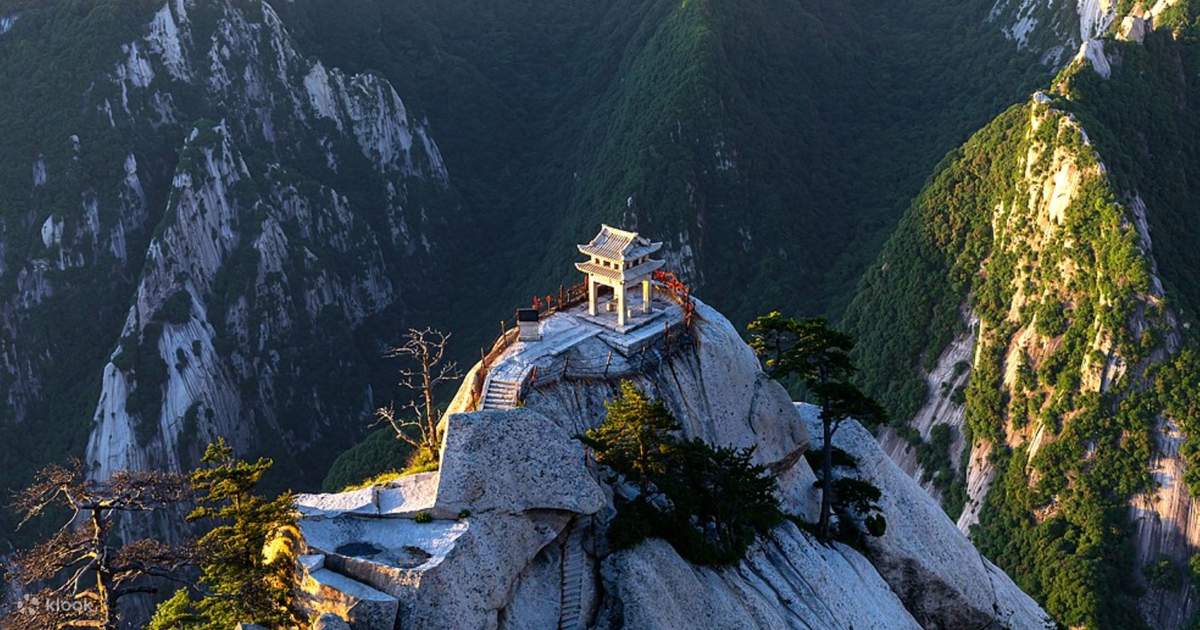
Huashan_Scenic_Area.
Recommended Itinerary
For visitors looking to blend a hike with cultural exploration, consider this itinerary:
- Day 1: Arrival in Xi’an.
- Day 2: Visit the Terracotta Army.
- Day 3: Explore Mount Huashan.
- Day 4: Discover Xi’an’s city highlights before departure.
Final Thoughts
Visiting Mount Huashan is not just a hike; it’s an immersion into the rich tapestry of Chinese history and natural beauty. Whether you are seeking adventure or tranquility, the breathtaking landscapes and historical significance of this mountain will leave an indelible mark on your journey through China. Prepare accordingly, respect the mountain’s challenges, and enjoy the unparalleled beauty that awaits you at Huashan!
Tickets: Prices, Booking, and Tips
Visiting Huashan Scenic Area is an unforgettable experience, and understanding the ticketing process, prices, and some handy tips can make your journey smoother. Here’s everything you need to know to plan your visit to this iconic mountain.
Ticket Prices
Huashan Mountain has a tiered pricing system based on the type of access you require. As of the latest updates, here are the general ticket prices:
- Admission Ticket: Approximately ¥180 (about $25) per person. This ticket grants you access to the scenic area, including the hiking trails and the various peaks.
- Cable Car Tickets:
- North Peak Cable Car: Around ¥80 (about $12) one way, ¥120 (about $18) round trip.
- West Peak Cable Car: Approximately ¥80 (about $12) one way, ¥120 (about $18) round trip.
Note: Prices can vary, so it’s wise to check for any seasonal promotions or changes before your visit.
Booking Tickets
While tickets can be purchased on-site, booking in advance is recommended, especially during peak seasons (April to October). Here’s how you can secure your tickets:
- Online Booking: Websites like Ctrip or Klook offer the option to buy tickets online, allowing you to skip the long queues at the ticket counter.
- Hotel Concierge: Many hotels in Xi’an can assist with booking tickets for Huashan, so don’t hesitate to ask them for help.
- Tour Packages: Consider booking a guided tour that includes transportation, entrance fees, and a local guide. This can be particularly helpful for first-time visitors.
Tips for Visiting
- Early Start: Arriving early can help you avoid the crowds, especially if you’re planning to hike to the peaks. The sunrise views from East Peak are worth the early wake-up call!
- Physical Preparedness: Ensure you’re in good physical condition, especially if you plan to hike between the peaks. The trails can be steep and challenging.
- Weather Check: Before your visit, check the weather forecast. Huashan can be prone to fog and rain, which can impact visibility and hiking conditions.
- Safety Gear: Wear sturdy hiking shoes and bring water and snacks. The trails can be strenuous, and staying hydrated is crucial.
- Peak Visiting Hours: Try to avoid weekends and public holidays if possible, as these periods can see an influx of visitors, leading to longer wait times for the cable cars.
- Restrictions: Be aware of the age and height restrictions for certain adventurous activities like the Plank Walk or Sparrow Hawk Flips Over, and prepare accordingly.
Conclusion
Whether you choose to hike the trails or take the cable car for a more leisurely experience, Huashan Mountain offers breathtaking views and a deep connection to China’s cultural heritage. By understanding ticketing options and planning ahead, you can ensure your visit is as enjoyable and memorable as possible. Prepare for an adventure that will stay with you long after your journey ends.
How to Get There: A Complete Transportation Guide
Getting to Huashan Scenic Area: Your Comprehensive Transportation Guide
Visiting the majestic Huashan Mountain, one of China’s Five Great Mountains, requires some planning to ensure a smooth journey. Whether you’re an adventurous hiker or a culture enthusiast, here’s how to make your way to this breathtaking destination.
1. Starting from Xi’an
Xi’an, the capital of Shaanxi Province and a city rich in history (home to the Terracotta Warriors), serves as the primary gateway to Huashan. The journey from Xi’an to Huashan is straightforward, and there are several options available:
-
Private Car Transfer:
The most convenient way to reach Huashan is by hiring a private car. This option allows you to travel directly to the tourist center at the foot of the mountain in about 1.5 hours. This is particularly beneficial if you’re traveling with family or a group. -
Bullet Train:
For a more cost-effective solution, take a bullet train from Xi’an to Huashan North Railway Station. The train ride lasts around 30-40 minutes. Upon arrival, you’ll need to transfer to the tourist center, which can be done via: - Bus: There are shuttle buses that run from the train station to the tourist center. Be prepared for a potential wait time, especially during peak seasons.
- Taxi: Taxis are also available, but they may charge extra, particularly if you’re catching one after a long day of hiking.
2. Reaching the Cable Car Stations
Once at the tourist center, you’ll need to navigate to one of the two cable car stations to access Huashan’s peaks.
-
Shuttle Bus:
The tourist center typically provides shuttle buses to both the North Peak and West Peak cable car stations. The journey takes approximately 20 minutes. -
Walking:
If you’re feeling adventurous and have the time, you can also opt to walk to the cable car stations. This will give you an opportunity to soak in the surrounding scenery, though be prepared for a longer trek.
3. Choosing Your Cableway
Huashan offers two main cable car routes, each leading to different peaks:
-
North Peak Cable Car:
This is the most popular starting point for those who wish to hike the various trails connecting the peaks. It allows for a quick ascent to North Peak, where you can begin your exploration. -
West Peak Cable Car:
This route takes you directly to West Peak, known for its stunning views and stunning sunsets. This is a great option if you prefer to start your visit with a more leisurely pace.
4. Hiking and Exploring
After reaching the peak via cable car, you can embark on hiking adventures to the other four peaks:
- North Peak to Middle Peak: Accessible through a thrilling narrow path known as Black Dragon Ridge.
- Middle Peak to East Peak: Enjoy the famous Sparrow Hawk Flips Over climbing challenge.
- South Peak: Experience the exhilarating Plank Walk.
- West Peak: The best spot to catch the sunset.
Whether you choose to hike between the peaks or take the cable cars, each route offers unique views and challenges.
5. Best Times to Travel
To avoid crowds and enjoy the most pleasant weather, aim to visit Huashan between April to October, with the ideal months being April-May and September-October. During these periods, you can enjoy clear skies and moderate temperatures, perfect for hiking.
Conclusion
Traveling to the Huashan Scenic Area is an adventure in itself, blending modern transportation with the exhilarating experience of nature and history. With options ranging from private transfers to bullet trains and cable cars, your journey to one of China’s most iconic mountains can be tailored to fit your preferences. Prepare well, and you’ll be rewarded with awe-inspiring views and unforgettable memories.
Local Cuisine and Accommodation Nearby
Savoring Local Flavors and Finding Comfort Near Huashan
As you prepare to embark on your adventure at Mount Hua, indulging in the local cuisine and finding suitable accommodation will enhance your experience amid this breathtaking landscape steeped in history. Nestled near Xi’an, Huashan not only offers stunning vistas but also a rich culinary tapestry and comfortable lodging options.
Local Cuisine: A Taste of Shaanxi
The region surrounding Huashan is renowned for its distinctive flavors, deeply influenced by the historical Silk Road. When visiting, be sure to sample some of the following local delights:
-
Biangbiang Noodles (油泼面): Known for their wide, flat shape, these hand-pulled noodles are often served with a spicy chili oil and a mix of vegetables. This dish is a must-try for noodle lovers and represents the heart of Shaanxi cuisine.
-
Roujiamo (肉夹馍): Often referred to as a Chinese hamburger, Roujiamo is a flaky bread filled with tender, braised meat, usually pork or beef, seasoned with a medley of spices. A perfect snack to fuel your mountain hikes!
-
Yangrou Paomo (羊肉泡馍): A hearty dish made with lamb and crumbled bread, this comforting bowl is perfect for warming up after a day of hiking. It’s a staple in Xi’an and a great way to experience local flavors.
-
Pomegranate Juice: The region is famous for its pomegranates, and freshly squeezed juice is a refreshing treat available at many local stalls, especially during the summer months.
Accommodation Options: Your Mountain Retreat
While lodging options atop the mountain are limited, several accommodations near the base of Huashan offer comfort and convenience.
-
Mount Hua East Peak Hotel: This hotel is a popular choice for those wishing to witness the spectacular sunrise over East Peak. Although the amenities are basic, with shared bathrooms and limited room sizes, its location provides easy access to the hiking trails.
-
Huashan International Hotel: Located at the foot of the mountain, this hotel combines modern comfort with traditional Chinese hospitality. Featuring well-furnished rooms and a restaurant serving local cuisine, it’s an excellent base for exploring the area.
-
Hostels and Guesthouses: For budget-conscious travelers, there are several hostels and guesthouses in the nearby town of Huayin. These offer dormitory-style accommodations and the chance to meet fellow adventurers.
-
Camping: If you’re feeling adventurous, consider camping at Middle Peak. While you will need to bring your own gear, camping under the stars offers an unparalleled experience, allowing you to soak in the serene atmosphere of Huashan.
Tips for a Memorable Experience
-
Make Reservations: During peak season (April to October), it’s wise to book your accommodation in advance to secure your spot, especially if you aim to catch the sunrise.
-
Pack Snacks: While you can find food vendors on the mountain, having some snacks on hand can be helpful during your hikes, especially if you plan to tackle multiple peaks in one day.
-
Cultural Etiquette: Embrace the local customs and be respectful when dining. It’s customary to share dishes, so don’t hesitate to try a bit of everything when dining with friends or fellow travelers.
By immersing yourself in the local cuisine and ensuring comfortable accommodations, your visit to Huashan will be enriched with unforgettable flavors and restful nights, making your journey through one of China’s most stunning landscapes all the more enjoyable.
Frequently Asked Questions
Frequently Asked Questions about Huashan Scenic Area
1. What is Huashan Mountain known for?
Huashan Mountain, one of China’s Five Great Mountains, is celebrated for its breathtaking sheer cliffs and deep ravines, earning the title of “the most precipitous mountain under heaven.” It features five distinct peaks, each offering unique views and hiking experiences, as well as numerous Taoist temples and historical sites.
2. How do I get to Huashan from Xi’an?
The most convenient way to reach Huashan from Xi’an is by private car, which takes approximately 1.5 hours to the tourist center. Alternatively, you can take a bullet train to either Huashan or Huashan North Railway Station, followed by a bus or taxi to the cable car stations. Keep in mind that public transport may involve longer wait times.
3. What are the best times to visit Huashan?
The ideal months to visit Huashan are from April to October, with April to May and September to October offering the best weather conditions, clearer skies, and fewer crowds. Each season has its charms, such as spring blossoms, summer greenery and sea of clouds, autumn colors, and winter snow and rime.
4. Are there cable cars available, and where do they lead?
Yes, there are two cable cars at Huashan. One cableway takes you to the North Peak, while the other leads to the West Peak. Both cable cars provide access to stunning views and allow for a less strenuous hiking experience, although you will still need to hike to reach the other peaks.
5. What hiking routes do you recommend?
For a classic experience, the North Peak to West Peak route is highly recommended, where you can enjoy a mix of cable car and hiking. Alternatively, the West Peak up and North Peak down route is less crowded and mostly downhill. For the adventurous, a two-day complete hiking tour is available, allowing you to conquer all five peaks at a leisurely pace.
6. What accommodations are available on the mountain?
Accommodations are limited at Huashan, with the Mount Hua East Peak Hotel being the most convenient for witnessing sunrises. Rooms are basic, often dormitory-style, and may not include private bathrooms. For those seeking a more adventurous experience, camping is possible, especially at Middle Peak.
7. Are there any age or height restrictions for certain attractions?
Yes, some attractions, such as the Plank Walk and the Sparrow Hawk Flips Over, have age and height restrictions. Generally, participants must be between 15 and 55 years old and meet minimum height requirements (usually around 150-160 cm). It’s recommended to check specific guidelines for each activity before your visit.
8. What should I pack for my trip to Huashan?
When visiting Huashan, it’s essential to pack sturdy hiking shoes, weather-appropriate clothing, water, snacks, and a camera for stunning views. A hiking pole can also be helpful. Don’t forget to check the weather forecast before your trip, as conditions can change rapidly on the mountain.
Final Thoughts on Your Trip
As you reflect on your journey to the breathtaking Huashan Scenic Area, you undoubtedly carry with you a tapestry of unforgettable experiences. From the exhilarating hikes along its sheer cliffs to the serene moments spent at ancient Taoist temples, Mount Hua offers an unparalleled adventure for those seeking to immerse themselves in the rich tapestry of Chinese history and culture.
A Journey Through Time and Nature
Huashan is not just a destination; it is a pilgrimage of sorts—a place where the ancient meets the adventurous. The mountain has been revered for centuries, a sanctuary for those seeking spiritual enlightenment and a test of endurance for thrill-seekers. The paths you traversed, whether via the daring Plank Walk or the scenic cable car, tell stories of countless travelers who have come before you, each leaving their mark on this sacred site.
Captivating Views and Cultural Riches
As you stand atop the peaks, gazing at the panoramic vistas that stretch endlessly before you, take a moment to appreciate the breathtaking beauty of nature juxtaposed with the profound cultural heritage that surrounds you. The sunrise at East Peak and the sunsets from West Peak are moments that will forever linger in your memory, reminding you of the magic that exists when nature and culture intertwine.
Practical Insights for Future Travelers
For those planning their own adventure, remember to choose the season wisely—spring and autumn offer the clearest skies and the most comfortable hiking conditions. Embrace the challenges that Huashan presents; the rewards are well worth the effort. Whether you are a seasoned hiker or a curious traveler, the mountain welcomes all, urging you to explore its depths and heights.
In Closing
Your visit to Huashan is not merely a trip; it is an invitation to connect with the spirit of China, to walk the paths of history, and to appreciate the stunning landscapes that have inspired poets and philosophers for centuries. As you descend from its heights, carry the essence of Huashan with you, a reminder of the adventures and insights that await those who dare to explore. May your travels continue to be filled with discovery, inspiration, and the rich tapestry of cultures that makes our world so wonderfully diverse.